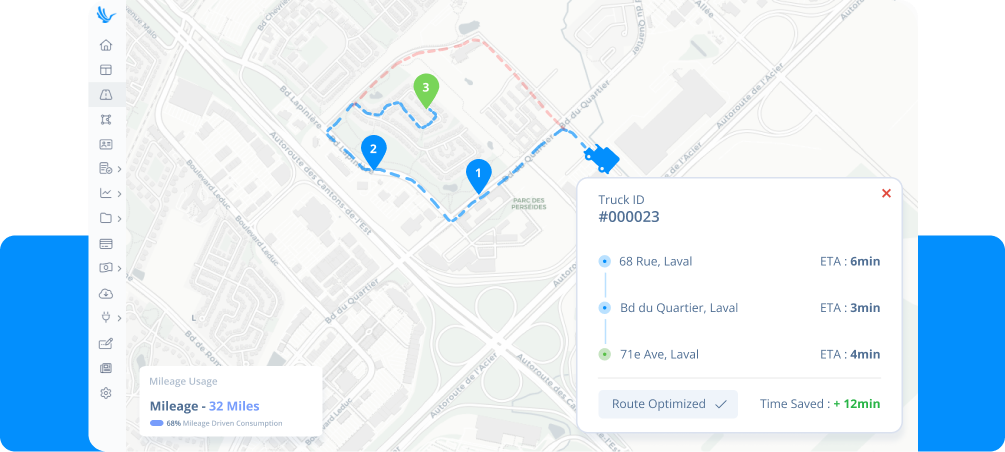
Dynamic Routing Optimization
Software
Unlock the full potential of your delivery operations with Cigo Tracker’s delivery route optimization system.
over 1000+ brands
proudly partnered up with Cigo Tracker
over 1000+ brands
proudly partnered up with Cigo Tracker

Precision in Timing
Dynamic, Precise ETAs
Auto-Generated
Deliver with confidence using Cigo Tracker’s auto-generated, dynamic ETAs and accurate time windows, ensuring reliability and customer satisfaction.


Predict and Forecast Future Routes, Regions, and Zones
Stay ahead with Cigo Tracker by predicting and planning for future delivery routes, regions, and zones, optimizing for what’s next.
Optimize Capacity
Achieve More Deliveries With Less Mileage.
Maximize your fleet efficiency with our delivery optimization software by reducing underutilized vehicle capacity, enabling more deliveries with fewer miles traveled.

Learn How You Can Significantly Save On Gas
Experience substantial fuel savings, enhancing your bottom line. Cigo Tracker’s route optimization solution leads to an average of 20% reduction in fuel consumption.

What Our Customers Are Saying
Dynamic Route Optimization
Embrace unparalleled route optimization with Cigo Tracker’s ‘Dynamic Route Optimization Solutions: Harnessing Data and Agility.
Optimize by 15+ datapoints
Empower your route planning with Cigo Tracker’s analysis of over 15 datapoints, tailoring every journey for peak performance.
Utilize real time data
Leverage Cigo Tracker’s real-time data utilization for cutting-edge courier route optimization software, ensuring the most efficient delivery paths.
Auto optimize and recalculate
Cigo Tracker instantly recalculates and optimizes routes in response to changes, maintaining efficiency without skipping a beat.
Try Cigo Tracker
With No Commitment for 14 Days
Our 14-day trial, offered without any commitment, is designed to let you experience firsthand the game-changing benefits of our comprehensive delivery route optimization software.
Optimize your deliveries
Elevate Your Delivery Operations with Cigo Tracker
Ready to redefine the future of your delivery operations? Cigo Tracker’s dynamic route optimization solution is your key to unlocking unparalleled efficiency, reducing costs, and delivering exceptional customer experiences.
By harnessing the power of real-time data and advanced algorithms, Cigo Tracker empowers you to optimize delivery routes, minimize idle time, and maximize driver productivity. Experience the transformative impact of Cigo Tracker today.

Learn more about Cigo
Frequently Asked Questions
What is Dynamic Route Optimization?
Dynamic route optimization is a technology that leverages real-time data to continually adjust delivery routes. By factoring in traffic conditions, road closures, and other variables, it helps businesses optimize delivery schedules, reduce fuel consumption, and improve customer satisfaction. Additionally, dynamic route optimization can be tailored to split routes based on specific regions or zones, which can be customized by day of the week to accommodate varying delivery demands.
How Does Dynamic Route Optimization Benefit Delivery Operations?
Dynamic route optimization offers several key benefits:
- Improved Efficiency: Real-time route adjustments minimize mileage and delivery times.
- Enhanced Customer Satisfaction: Accurate ETAs and timely deliveries boost customer satisfaction.
- Reduced Costs: Optimized routes lead to lower fuel costs and reduced operational expenses.
- Environmental Impact: By minimizing mileage, dynamic route optimization helps reduce carbon emissions.
Can Cigo Dynamically Optimize Routes?
Yes, Cigo’s built-in dynamic route optimization feature allows you to leverage real-time data to optimize delivery routes and schedules. This ensures your drivers take the most efficient paths, even in changing conditions.
How Does Dynamic Route Optimization Improve Customer Experience?
By providing accurate ETAs and timely deliveries, dynamic route optimization enhances the customer experience. It also allows for better communication with customers, keeping them informed about any potential delays.
How Does Dynamic Route Optimization Adapt to Changing Conditions?
Dynamic route optimization software continuously monitors real-time data, such as traffic conditions and road closures. It then adjusts routes accordingly to ensure optimal delivery efficiency.
What are the Challenges of Implementing Dynamic Route Optimization?
While dynamic route optimization offers significant benefits, it requires careful planning and implementation. Challenges may include:
- Initial Setup: Implementing the technology and integrating it with existing systems can be time-consuming.
- Driver Training: Drivers may need training to adapt to new routing strategies and technology.
- Data Quality: Accurate and reliable real-time data is essential for effective route optimization.
How Does Dynamic Route Optimization Contribute to Sustainability?
By minimizing fuel consumption and reducing carbon emissions, dynamic route optimization helps businesses operate more sustainably. It aligns with the growing global focus on environmental responsibility and can help businesses meet their sustainability goals.
